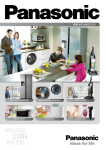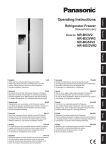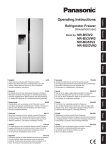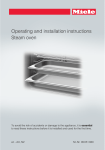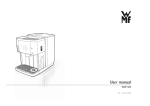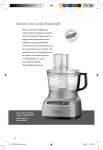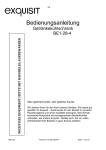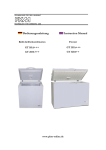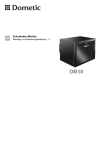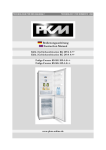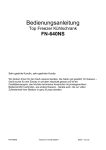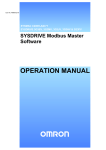Download Operating Instructions
Transcript
Refrigerator-Freezer English Operating Instructions (Household use) NR-B53V1 NR-B54X1 Deutsch Model No. Nederlands Français Italiano 2-29 Thank you for purchasing this Panasonic product. Please read these instructions carefully before using this product. Please keep this manual for future reference. Included installation Instructions. 170-197 Gratulerar till ditt inköp av denna Panasonic-produkt. Läs noggrant igenom denna bruksanvisning före användningen. Spara denna bruksanvisning för framtida bruk. Anvisningar om installationen är inkluderade. 30-57 Norsk 198-225 Takk for at du valgte å kjøpe dette produktet fra Panasonic. Les disse instruksjonene nøye før du bruker produktet. Ta vare på denne håndboken i tilfelle du får bruk for den senere. Instruksjoner for installasjon medfølger. Nederlands Dansk 58-85 226-253 Tak fordi du har valgt dette produkt fra Panasonic. Læs venligst nærværende instruktioner, inden du tager dette produkt i brug. Gem venligst denne brugsanvisning, inklusive installationsanvisningerne, til fremtidig reference. Français Polski 86-113 254-281 Dziękujemy za zakup produktu firmy Panasonic. Prosimy o dokładne przeczytanie niniejszych instrukcji przed korzystaniem z niniejszego produktu. Prosimy o zachowanie niniejszego podręcznika do wykorzystania w przyszłości. Zawiera instrukcje instalacyjne. Italiano Česky 114-141 La ringraziamo per aver acquistato questo prodotto Panasonic. Leggere attentamente le istruzioni prima di usare il prodotto. Conservare il presente manuale per consultazioni future. Le istruzioni per l'installazione sono incluse. 142-169 Muchísimas gracias por haber adquirido este producto de Panasonic. Lea atentamente estas instrucciones antes de usar este producto. Guarde este manual para poder consultarlo en el futuro. Se incluyen instrucciones para la instalación. Česky Español 282-309 Děkujeme vám za zakoupení tohoto produktu Panasonic. Před použitím si důkladně přečtěte tyto pokyny. Uschovejte tento návod pro budoucí využití. Návod k instalaci je přiložen. Polski Nous vous remercions d’avoir acheté un produit Panasonic. Veuillez lire ce mode d’emploi attentivement avant d’utiliser ce produit. Prière de conserver ce mode d’emploi pour toute référence ultérieure. Instructions d’installation incluses. Dansk Hartelijk dank voor uw aankoop van dit Panasonic product. Lees deze aanwijzingen aandachtig door voordat u dit product in gebruik neemt. Bewaar deze handleiding voor latere naslag. Inclusief installatiehandleiding. Norsk Wir danken Ihnen für den Kauf dieses Panasonic-Produkts. Bitte lesen Sie diese Anweisungen vor der Benutzung dieses Produkts sorgfältig durch. Bitte bewahren Sie diese Anleitung für spätere Bezugnahme auf. Installationsanleitung enthalten. Svenska Deutsch Svenska Español English Introduction Contents Introduction Caring for the environment...................................................................................... 2 Installation Installation.................................................................................................................. 6 Operation Parts and their functions........................................................................................ 14 Safety instructions.................................................................................................... 3 Choosing the right location......................................................................... 6 Removing the doors................................................................................... 7 Connecting the refrigerator to the water supply......................................... 9 Installing the water filter........................................................................... 11 Installing the refrigerator.......................................................................... 12 Preparations............................................................................................. 13 Interior and foods stored.......................................................................... 14 Exterior and operation panel.................................................................... 16 Setting the temperature.......................................................................................... 18 Using the handy functions..................................................................................... 19 How to use the Ice/Water dispenser...................................................................... 21 Concerning the user alert functions...................................................................... 21 Appendix Removing and re-installing.................................................................................... 22 Cleaning and maintenance..................................................................................... 23 Cleaning................................................................................................... 23 Changing the water filter.......................................................................... 24 Stopping the automatic ice-making.......................................................... 25 Checks after cleaning and maintenance.................................................. 25 When the refrigerator is not going to be used for a prolonged period...... 25 When moving or transporting the refrigerator.......................................... 26 Troubleshooting...................................................................................................... 27 Caring for the environment Disposing of the packaging Please recycle where possible (e.g. cardboard, plastic bags, adhesive tape and polystyrene) and make sure you dispose of all other packing materials safely. Keep the packaging out of the reach of babies and young children, to avoid injury or suffocation. Before disposing of your old appliance Please follow either the disposal instructions from the manufacturer of the old appliance, or local disposal regulations for the appliance. Where this is not available, please follow the three step instructions below. 1. Remove the plug from the socket. 2. Cut the supply cord off, and safely dispose of it with the mains plug still attached. 3. Until the old appliance is collected, or you take it to a Recycling Centre, make sure it’s out the reach of small children. ● Remove all sealing materials from the door and leave all the shelves and drawers in place. This way, children are less likely to climb in and become trapped. 2 Introduction Safety instructions Indicates the appliance must be earthed to prevent electric shock Make sure you do this Do not take apart English Do not Indicates risk of death or serious injury. WARNING This appliance is not intended for use by persons (including children) with reduced physical, sensory or mental capabilities, or lack of experience and knowledge, unless they have been given supervision or instruction concerning use of the appliance by a person responsible for their safety. Children should be supervised to ensure that they do not play with the appliance. Do not use a multiple socket adaptor and plug several appliances into the same socket adaptor. ●●This can cause overheating, fire or short circuit. Do not pinch, knot, or bend the supply cord, or place heavy objects on it. ●●This increases the risk of fire or electric shock. If the supply cord or plug of the appliance is damaged, it must be replaced by the manufacturer, its service agent or similarly qualified person in order to avoid a hazard. Do not unplug the refrigerator by pulling on the supply cord. ●●This can damage to the supply cord. Always grip the plug and pull firmly from the socket. Do not place any water container on the top of the refrigerator. ●●Water can damage insulation of electrical components and cause short circuit, fire or electric shock. Do not spray inflammable gas near the refrigerator. ●●This can cause explosion or fire. Do not spray water onto or into the refrigerator. ●●This can cause fire or electric shock. Do not touch the power plug with wet hands. ●●This can cause electric shock. Do not install the refrigerator in a damp place, or where it may come into contact with water. ●●Deteriorated insulation of electrical parts can cause short circuit, electric shock or fire. Do not store volatile or flammable substances in the refrigerator. ●●Flammable substances such as benzene, thinners, alcohol, ether and Liquid Petroleum Gas (LPG) can cause explosions. Do not store pharmaceuticals or other temperature-sensitive products in the refrigerator. ●●You should not store products that require strict temperature controls in the refrigerator. Do not let children climb, swing or hang on the refrigerator door. ●●This can cause serious injury, as well as damaging the refrigerator. Do not operate the refrigerator in the presence of explosive fumes or flammable gas. ●●This can cause explosion or fire. Do not store petrol or other flammable liquids and vapours in the refrigerator, or use them near the appliance. ●●This can cause explosion or fire. Do not use mechanical devices or other means to accelerate the defrosting process, other than those recommended by the manufacturer. ●●This can cause damage to the interior of the refrigerator or cause an explosion. 3 Introduction Do not use electrical appliances inside the food storage compartments of the appliance, unless they are of the type recommended by the manufacturer. Do not touch the crusher blades of the icebox. Do not poke your fingers into the hole where the ice is dispensed from the Ice/Water dispenser. ●●Failure to do this may result in an injury to yourself. Do not try to disassemble, repair or modify the refrigerator yourself. ●●You may injure yourself – or others – with burns or electric shock, or damage the refrigerator. If your appliance needs alterations or repair, please consult authorized service centre. Ensure that the refrigerator is plugged into an earthed mains socket. DO NOT plug into an unearthed mains socket. Make sure the supply cord and plug are not squashed or damaged. ●●A damaged power plug or cord can cause short-circuit, fire or electric shock. ●●If the supply cord is damaged, it must be replaced by the manufacturer, its service agent or similarly qualified persons in order to avoid a hazard. ●●DO NOT ATTEMPT TO REPLACE IT YOURSELF. Remove any dirt or dust from the plug’s pins before connecting to the power supply. ●●Dust build-up on the plug can cause insulation failure, especially in humid conditions. This can cause short circuit, fire or electric shock. Unplug the supply cord and wipe it with a dry cloth. Never use a wet or damp cloth. Plug your appliance into the socket, making sure the connection is secure. ●●A loosely connected power plug can cause fire or electric shock. Install the refrigerator in a well-ventilated area. ●●The more refrigerant there is in an appliance, the larger the room it should be installed in. If there’s a refrigerant fluid leak, and the appliance is in a small room, the build up of combustible gases is more likely. This can cause fire or explosion. As a guide, for every 8 g of coolant, you’ll need at least 1 cubic metre of space in the room. The data plate inside the appliance tells you how much refrigerant your refrigerator contains. ●●Keep ventilation openings, in the appliance enclosure or in the built-in structure, clear of obstruction. The refrigerant (R600a) used in the refrigerator and the gases in the insulation material (cyclopentane) are both flammable. They also require special disposal procedures. ●●Before you dispose of the appliance, make sure none of the pipes on the back are damaged. Refrigerant or gas leaks can cause fire or explosion. ●●Do not damage the refrigerant circuit. Unplug the refrigerator before cleaning and servicing. ●●Failure to do this can cause electric shock. If you smell burning or see smoke coming from the refrigerator, disconnect the power immediately and please consult authorized service centre. Connect potable water supply only. The new hose – sets supplied with the appliance are to be used and that old hose – sets should not be reused. The ice maker in refrigerator must be installed only by the manufacture or its service agent except ice storage box. ●●Ice maker type : EAU37119711, EAU37119712 4 LED RADIATION DO NOT VIEW DIRECTLY WITH OPTICAL INSTRUMENTS CLASS 1M LED PRODUCT Introduction Indicates risk of injury or damage to property. Do not put glass bottles or containers in the freezer. ●●When the contents freeze, the glass may break. English CAUTION Do not touch the inside walls of the freezer or items stored in the freezer with wet hands. ●●Your skin can become frozen onto the interior wall, or items stored in the freezer. Do not open or close the doors by taking hold of the door handles with both hands. ●●This may cause personal injury. Do not touch the ice maker with your hand or a tool. ●●The ice maker rotates automatically. This may cause personal injury or trouble. Do not put your hand or things in the ice shooter. ●●This may cause personal injury or trouble. If there’s a power cut, avoid opening the refrigerator frequently or putting unchilled food in it. ●●This can cause the temperature in the refrigerator to rise and spoil food stored inside. If you’re not going to use the refrigerator for a long time, unplug it from the mains. Also, be careful of the gap between the fridge and freezer doors, especially if they are both open at the same time. ●●This may cause personal injury. When opening the refrigerator, be careful not to pinch your fingers at the “pinch point” areas. ●●This can cause personal injury. Potential pinch point Keep children from touching the ice maker and icebox. ●●Otherwise, they may be injured. Stop using this ice maker and contact an authorized service centre if discoloured ice was made during use. 5 Installation Installation Choosing the right location Install the refrigerator in a location which satisfies the following criteria: ●●Where there is a main water supply line nearby ●●Where the refrigerator will not be exposed to direct sunlight ●●Where the refrigerator will be at a distance from heating appliances, cooking appliances and other sources of heat ●●A location which is well-ventilated and dry ●●Where the floor is sturdy and level Place a solid board underneath if the refrigerator is to be installed on top of a carpet or vinyl floor. The board will protect the floor from becoming deformed and discoloured. Provide clearance to allow heat to dissipate 30 mm or more Residual heat is always being emitted from the refrigerator while it is operating. Provide sufficient clearance around the refrigerator to allow this heat to dissipate so that its cooling ability is not impaired. 50 mm or more Dimensions (mm): W905 × D710 × H1850 25 mm or more Installing the spacers Install the spacers on the back panel of the refrigerator to ensure the minimum amount of space required to allow the heat generated by the refrigerator. Spacers Attach to the back panel of the refrigerator after removing the double-sided tape's release liner. Spacer (accessory) When the doors are completely open 150˚ 150˚ 1675 mm 6 900 mm 384 mm 974 mm 1032 mm 319 mm 426 mm 989 mm 900 mm 944 mm 349 mm When the inside drawers have been taken out 140˚ 140˚ 1603 mm Installation Removing the doors CAUTION Before removing the doors, be absolutely sure to check that the power of the refrigerator has been turned off. When you want to remove the doors, please contact your dealer, an authorized service centre or access to our Web site (http://panasonic.net). Panasonic or its Authorized agent cannot be held responsible if you remove the doors by yourself. English If the refrigerator will not pass through a doorway or entrance, its doors can be removed. Dimensions (mm): W900 × D610 × H1845 (Without Door) Removing the front grille When the two doors are opened and the front grille is viewed from above, two screws – one on the left and the other on the right – will be seen. Turn these screws counterclockwise, and remove them. There is a connecting area slightly to the right of the centre of the front grille on its bottom. Take hold of this area, and pull the grille toward you to remove it. Disconnecting the water supply hoses Remove the connecting ring (black) of the water supply connector, pressing the coupler and pull the water supply hose free. ●●There are two water supply hoses, one for the Ice dispenser and one for the Water dispenser. Disconnect both of them. Front grille Connecting area Water supply connector Connecting ring Coupler Reconnecting the water supply hoses First insert the connecting ring (black) into the water supply connector, and then insert the water supply hose. Insert the water supply hose into the water supply connector until the printed line on the hose is no longer visible. ●●Two water supply hoses connect the same colour. Line Connecting ring 7 Installation Removing the freezer door When removing the door ●●Ensure the door is in the closed position. ●●Take care not to bend the hinges or damage the water supply hoses. ●●Handle the removed door carefully to keep it safe from damage and impact. 1Remove the top hinge cover. Turn the hinge cover screw counterclockwise, and remove it. 2Disconnect the connecting cable. While pressing on the knob, pull out the cable in the direction shown by the arrow. 3Remove the top hinge. Turn the hinge screws and the grounding screw counterclockwise, and remove them. ●●When removing the top hinge, take care to support the door so that it will not topple forward. 1 3 2 Knob 4Remove the hose guide, and remove the door. Remove the hose guide from the bottom hinge in the direction shown by the arrow. And then lift the door straight up from the bottom hinge, and remove it. ●●Pull out the water supply hoses so that it is completely disconnected. Hose guide Removing the fridge door When removing the door ●●Ensure the door is in the closed position. ●●Handle the removed door carefully to keep it safe from damage and impact. 1Remove the top hinge cover. Turn the hinge cover screw counterclockwise, and remove it. 2Disconnect the connecting cable. While pressing on the knob, pull out the cable in the direction shown by the arrow. 3Remove the top hinge. Turn the hinge screws counterclockwise, and remove them. ●●When removing the top hinge, take care to support the door so that it will not topple forward. 1 3 2 Knob 4Remove the door. Lift the door straight up from the bottom hinge, and remove it. 8 Installation Attaching the doors and front grille English 1Follow the steps for removing the doors and grille in their reverse order. 2Tighten up fixing screws after checking that the door is parallel to the body and cold air does not leak from around the gasket. 3Tighten up screws to fix hinges using both the screwdriver (Phillips head) and hex wrench. 4When installing the front grille and top hinge cover, be sure not to get the hoses and cord caught in. When attaching the front grille, insert the hoses into the guides inside the front grille. Connecting the refrigerator to the water supply Before connecting the refrigerator A water pressure in the range of approx. 150 kPa to 700 kPa (22 psi to 102 psi) is must be to use the Ice/ Water dispenser. If the refrigerator is to be installed in a location where the water pressure is below approx. 150 kPa (22 psi), install a pressure pump to boost the natural water pressure. Connect potable water supply only. Parts required for the connection Connection kit (accessory) Hose connector (with strainer) for G 3/4 Joint (with packing) for G 1/2 Coupling hose connector Water filter 9 Installation Connecting the refrigerator Before proceeding any further, be absolutely sure to check that the power plug has been disconnected from the power outlet. And check the main water supply line has been shut off. When you want to connecting the refrigerator to the water supply, please contact your dealer, an authorized service centre or access to our Web site (http://panasonic.net). We could not be held responsible if you connect the refrigerator by yourself. 1Attach the hose connector to the water service pipe opening. Turn the hose connector clockwise to attach it. ●●After tightening up the hose connector as far as it will go by hand, use a tool to further tighten the hose connector through another half-turn or so. ●●Check that the strainer is fitted inside the hose connector. Case of G 3/4 Hose connector 1 Strainer Water service pipe opening 2Insert the coupling hose connector into the water service hose. Coupling hose connector 3Insert the water service hose into the end of the hose connector. ●●The water service hose is firmly inserted into the end of the hose connector. 3 2 Water service hose 4Tighten the coupling hose connector to the hose connector. Turn the coupling hose connector clockwise to attach it. ●●Tighten the coupling hose connector until space is lost between coupling hose connector and hose connector. 4 After the connection ends, turn on the main water supply line, and check that no water is leaking. Notes: ●●Failure to follow the steps as given above may cause water to leak. ●●Coil the excess length of the water service hose at the back of the refrigerator. Attach the hose connector to the G 1/2 type water service pipe opening. Case of G 1/2 Joint 1 -1 Packing Water service pipe opening 10 Hose connector 1 -2 Strainer Installation Installing the water filter English The water filter is not installed at the time the refrigerator is purchased. Install the water filter provided with the refrigerator. 1Remove the drawer of the Vitamin-Safe Zone. (The 2° Zone drawer in the case of model NR-B54X1.) 2 Filter panel 2Remove the filter panel. Place your fingers in the cutout at the front of the filter panel, and remove the filter panel. 1 3Install the water filter and rotate it 90 degrees clockwise. 3 Water filter 4Push the water filter down, and put the filter panel back in place. 4 Note: ●●Run water through the Water dispenser until the water runs clear (15 glass (approx. 3 litre)). This will clean the water supply system and remove air from the water supply hose. 11 Installation Installing the refrigerator The refrigerator comes on four casters to enable it to be moved easily. Carefully read through the section “Choosing the right location”, and install the refrigerator in the best location. Once the installation location has been decided upon, secure the refrigerator, and adjust it so that it is level. Removing the front grille When the two doors are opened and the front grille is viewed from above, two screws – one on the left and the other on the right – will be seen. Turn these screws counterclockwise, and remove them. There is a connecting area slightly to the right of the centre of the front grille at the bottom. Take hold of this area, and pull the grille toward you to remove it. Securing the refrigerator Front grille Connecting area Adjustable legs Insert a flat screwdriver into a slot on the adjustable legs at the left and right, turn them in the direction shown by the arrows to lower the legs to the floor level, and then secure the legs firmly. Levelling the refrigerator Turn the adjustable legs so that the refrigerator is installed flush with the floor. If the left and right doors are not flush with each other, turn one of the adjustable legs, and bring the doors into alignment. If the left door is lower than the right door Insert a flat screwdriver into a slot on the adjustable leg on the left, turn it in the direction shown by the arrow, and adjust. If the right door is lower than the left door Insert a flat screwdriver into a slot on the adjustable leg on the right, turn it in the direction shown by the arrow, and adjust. Attaching the front grille Follow the steps for removing the grille in their reverse order. ●●Take care not to pinch or damage the water supply hose. 12 Installation Preparations Remove all the packing materials and tapes. Wipe the inside of the refrigerator using a soft cloth which has been dipped in lukewarm water and then wrung out. Wash and completely dry the icebox before installing it. (Do not use a dish dryer, hair dryer or other appliance when drying.) English Maintenance Connecting the power plug to the power outlet When the power plug is connected to the power outlet, the temperature display starts flashing as shown in the figure on the right, and cooling starts inside the refrigerator. The temperatures displayed at this time are not the actual temperatures. When the temperature inside the refrigerator approaches the set temperature, the temperature display stops flashing and lights, and it shows the actual temperature. It takes about half a day to reach the set temperatures (when the room temperature is around 32 °C, there is no food inside the refrigerator, and the doors are closed). Place the food inside the refrigerator only after it was confirmed that the refrigerator compartment had been cooled. Notes: ●●Cooling may take longer in the summer months or at other times when the room temperature is higher. ●●While the temperature display is flashing, the alarm sounds to warn that the . temperature has risen. The alarm can be turned off by pressing ●●If you need to unplug the refrigerator, wait at least 10 minutes before you plug it back in again. You might damage the compressor. (model NR-B53V1) (model NR-B54X1) The Ice/Water dispenser and automatic ice maker Ice must first be made by the automatic ice maker before the Ice/Water dispenser can start dispensing ice. The automatic ice maker can make six cubes of ice at a time and about 60 cubes of ice a day (although this will differ depending on the prevailing conditions). When using the ice maker for the first time, it takes about 8 hours for ice to be made. Automatic ice-making stops as soon as the icebox becomes full. Note: ●●When using the Ice/Water dispenser and automatic ice maker for the first time, the water or ice may be discoloured or smell: this is normal and not indicative of any trouble. When water goes around through the water filter and pipes and other parts inside the refrigerator, these symptoms will disappear so keep supplying the water and removing the ice from Ice/Water dispenser until the discolouration/smell dissipates. In some homes, this procedure may have to be repeated a number of times. How to remove the icebox ●●Raise the icebox slightly, and pull the bottom part out toward you. (fig 1) How to set the icebox ●●First align its top part with the automatic ice maker, then push down its bottom part and insert it firmly into place below as far as it will go. ●●Be sure to hold the icebox with both hands. ●●Be sure to confirm that the icebox has been set firmly when installing. CAUTION (Fall of icebox may cause injury or trouble.) fig 1 1 2 fig 2 When the icebox can not be installed correctly ●●Insert the icebox to the original position completely after rotating the knob 90 degrees which located in the back of icebox as indicated in fig 2. 13 Operation Parts and their functions Interior and foods stored Shown in the illustrations of these instructions is the model NR-B53V1. 6 7 8 9 1 4 2 3 3 : 4 ; > < 5 = Freezer 1Automatic ice maker 2Icebox 3Glass shelves The positions of these shelves (except for the third shelf from the top in the freezer) can be adjusted. 4Door shelves The positions of these shelves (only the second shelf from the bottom in the fridge) can be adjusted. Egg tray, bottle stopper provided (one each). 8Hygiene active LED Antibacterial/deodorizing filter and LED. 9Sealed case door shelf :Suspend shelf (model NR-B53V1 only) ;0° Zone <Vitamin-Safe Zone (model NR-B53V1) Select temperature 0 °C to 5 °C and blue and green LED lights provided. 2° Zone (model NR-B54X1) 5Drawers =5° Fresh Zone Blue and green LED lights provided. 6Front tower LED light >Bottle stopper 7Wine rack 14 Fridge Operation Frozen foods, meats, fish, ice cream, etc. English Freezer -17 °C to -25 °C Butter, dairy products, eggs, drinks, seasonings, cooked foods, etc. 0° Zone Fridge 1 °C to 7 °C Vitamin-Safe Zone (model NR-B53V1) Meats, fish, ham, sausages, etc. Vegetables, fruits, etc. stored at low temperatures 2° Zone (model NR-B54X1) 5° Fresh Zone Vegetables, fruits, etc. Notes: ●●The 0° Zone, 2° Zone and 5° Fresh Zone temperatures change depending on the temperature set for the fridge. ●●A much larger space can be made available for use inside the freezer by removing the first and second drawers. 15 Operation Exterior and operation panel Control panel Ice/Water dispenser panel Ice/Water dispenser Door handle Ice/Water dispenser panel Display area 1Water filter change icon This indicates that it is time to change the water filter. 2Service engineer display This does not appear during normal operation. 3Filtered water dispense icon 1 2 3 4 5 6 7 4Crushed ice dispense icon 5Ice cube dispense icon 6Child Lock icon Control area 7Ice/Water dispenser button 16 Operation English Control panel Display area 1 1Cooling power level Cooling power by the refrigerator is indicated here. Lowest power level (when the compressor is shut down or running at lowest speed) 2 Low power level (when the compressor is running at low speed) 3 Medium power level (when the compressor is running at medium speed) 4 High power level (when the compressor is running at high speed) 5 2Fridge temperature 6 7 8 9 : 3Freezer temperature 4Vitamin-Safe Zone temperature (model NR-B53V1 only) 5Vitamin-Safe Mode (model NR-B54X1 has only the “ ” display) 6Super Freeze Mode ; 7Hygiene Active Mode 8Holiday Mode 9Eco Mode :Child Lock < Control area ;Up button = <Set button =Down button Notes: ●●Normally the panel displays are off. Displays appear when the buttons are operated, or the doors are opened. ●●The displayed temperature may differ from the actual temperature. ●●The buttons on the NR-B53V1 are operated by touching them, and the buttons on the NR-B54X1 are operated by pressing them. ●●This refrigerator uses a microprocessor to control the temperature. The temperature inside the refrigerator varies depending on such factors as changes in the room temperature, the speed at which the compressor is operating, how frequently the doors are opened and closed, and how much food is stored inside and how it is stored. 17 Operation Setting the temperature The temperatures of the fridge, freezer and Vitamin-Safe Zone can be changed. (The Vitamin-Safe Zone is provided with the model NR-B53V1 only.) At the time of purchase, the temperatures are set as shown below. Fridge: 4 °C Freezer: -20 °C Vitamin-Safe Zone: 2 °C 1 2 3 4 5 6 1The control panel lights up, the temperature inside the refrigerator is displayed. 2The temperature display start flashing, indicating that the temperatures can be set. 3The temperature set for the fridge starts flashing. 4Each time the button is pressed, the flashing display changes by one step in the sequence of fridge, freezer and Vitamin-Safe Zone. 5Adjust the temperature. ●●Press to raise the temperature and to lower it. 6The display stops flashing and lights up, indicating that the temperatures are now set. ●●Approximately 30 seconds later, the control panel goes off. Note: ●●The display in 1 is restored if no operations are performed for 5 or so seconds during the setting process. Fridge Set the temperature for the inside of the fridge. Any temperature within the range from 1 °C to 7 °C can be set. Notes: ●●When the temperature is set at 1 °C for a prolonged period, some food may freeze. ●●In the Holiday Mode, the temperature is not displayed, and the temperature cannot be set. ●●In the Eco Mode, the temperature cannot be set either. Freezer Set the temperature for the inside of the freezer. Any temperature within the range from -17 °C to -25 °C can be set. Note: ●●In the Eco Mode, the temperature cannot be set. Vitamin-Safe Zone Set the temperature of the Vitamin-Safe Zone (model NR-B53V1 only). Any temperature within the range from 0 °C to 5 °C can be set. Notes: ●●When the temperature is set between 0 °C and 1 °C for a prolonged period, some food may freeze. ●●In the Holiday Mode, the temperature is not displayed, and the temperature cannot be set. ●●In the Eco Mode, the temperature cannot be set either. 18 Operation Using the handy functions This refrigerator comes with a number of useful functions for specific applications. 2 3 4 5 English 1 1The control panel lights up. 2The function display start flashing, indicating that the functions can be set. 3“ ” starts flashing. (With the model NR-B54X1, “ ” starts flashing instead.) 4Select the function to be used. 5The display corresponding to the selected function stops flashing and lights up, indicating that the function is set. Each time the button is pressed, the display switches from “on” to “off”. On: The function is set. Off: The function is released. ●●Approximately 30 seconds later, the control panel goes off. Notes: ●●The display in 1 is restored if no operations are performed for 5 or so seconds during the setting process. ●●If the temperature display is flashing, wait about 5 seconds for the display to light up before proceeding with the operations above. 19 Operation Vitamin-Safe Mode Setting the Vitamin-Safe Zone and 5° Fresh Zone to the Vitamin-Safe Mode helps to protect the vitamin C contained in vegetables and fruit. (The model NR-B54X1 has only the 5° Fresh Zone.) The blue and green LED lights. Super Freeze Mode In this mode, the freezer can be cooled rapidly, enabling the fresh foods, etc. which are placed there to be frozen. The Super Freeze Mode is automatically released after about 50 hours. Notes: ●●When the Super Freeze Mode is set, the temperature inside the freezer may drop below the set temperature. ●●The compressor operates at high speed. ●●When the Super Freeze Mode is set while the Eco Mode is established, the Eco Mode is temporarily released. When Super Freeze Mode ends, operation in the Eco Mode will be restored. ●●The effect on the stored food can be reduced if setting the Super Freeze Mode several hours before storing the food in the freezer compartment. ●●The following items are recommended in order to exert the maximum freezing capacity. 1 Set the Super Freeze Mode 24 hours before storing the food. 2 Place the food on the second drawer from the top or on the glass shelf. (A bigger freezing capacity can be exerted if placing the food directly on the glass shelf.) ●●The maximum freezing capacity within 24 hours is written in the rating label. Hygiene Active Mode The hygiene active LED comes on, and food is protected from bacteria and odours. Holiday Mode Set this mode when the fridge is not going to be used for a prolonged period such as during a long vacation or when only the freezer is to be used. When this mode is set, the fridge temperature is not displayed. When this mode is set, the Vitamin-Safe Zone temperature is not displayed. (model NR-B53V1 only) Note: ●●When food with strong odours are to be stored, wrap it in plastic food wrap or place it inside a tightly sealed container. Otherwise, odours may be left in the fridge even if the Hygiene Active Mode has been set. Notes: ●●Before using the Holiday Mode, empty out the fridge, and close its door. ●●For hygiene reason, the temperature inside the fridge is kept at about 15 °C while the Holiday Mode is set. ●●The freezer is cooled in the usual way. Eco Mode Set this mode when the freezer is not going to be used much such as during the winter months or at night. Note: ●●The Eco Mode cannot be set while the Super Freeze Mode is set. Child Lock 20 The buttons on the control panel and Ice/Water dispenser panel can be locked. When the Child Lock is set, “ ” is displayed on the control panel and Ice/Water dispenser panel. To release this mode, hold down on the control panel for at least 3 seconds. Operation How to use the Ice/Water dispenser The Ice/Water dispenser can dispense water, crushed ice or ice cubes. English The Ice/Water dispenser panel lights up. The icon corresponding to what was dispensed last appears. Each time the button is pressed, the icon changes. Keep pressing the button until what you want to be dispensed is lit up. Guide Pad Place a cup against the pad and push it gently in. Water or ice is now dispensed from the Ice/Water dispenser. ●●During the dispensing, keep the cup or other container raised near the guide to ensure that the water or ice is not to be sprayed or spilt. The water that comes out of the Water dispenser is chilled to the appropriate temperature, but if water with a lower temperature is required, first place ice in a cup or other container before dispensing water. To prevent water or ice from splattering, pull the cup slowly away from the pad after all water or ice has been dispensed. ●●More ice may be dispensed for a few moments even after the cup has been pulled away from the pad. This is normal and not indicative of any malfunction. ●●Some ice or water that has remained into the guide may drop or run down for a few moments after it has been dispensed. This is normal and not indicative of any malfunction. Notes: ●●About 10 seconds after the button is operated, the Ice/Water dispenser panel goes off. When this panel is off, pressing the pad in has no effect. ●●In the Child Lock, “ ” is displayed under the button. ●●The water that comes out of the Water dispenser at the beginning may have a slightly higher temperature. ●●Place only the ice made by this refrigerator – and no other type of ice – in the icebox. Trouble may occur if you fail to heed this warning. ●●If the ice maker produces ice that is too small, the amount of water supplied to the ice maker can be adjusted. Contact your dealer or an authorized service centre. ●●If you continue pushing the pad for more than 30 seconds, the Ice/Water dispenser will automatically stop dispensing water or ice. Concerning the user alert functions The following user alert functions are activated when a door has been left ajar for a prolonged period of time or when the temperature inside the refrigerator has risen. Temperature display Continuous for 1 minute Door ajar Front tower LED light Blinks Sounds once Blinks once Continuous for 3 minutes Blinks Sounds twice Blinks twice Continuous for 5 minutes Blinks* Sounds continuously Blinks continuously Freezer: -12 °C or more Temperature rise inside the refrigerator Fridge: 8 °C or more Alarm Blinks* Sounds continuously Normal operation Blinks* Sounds continuously Normal operation *Blinks for 30 seconds every 30 minutes. 21 Appendix Removing and re-installing Glass shelves 1 Raise the back part of the shelf slightly, and pull out the shelf. To re-install the shelf, align it with the left and right guides, and push it into place. 2 Drawers Pull the drawer out all the way, and while raising the back part of the drawer slightly, and pull out the drawer. To re-install the drawer, align it with the left and right guides, and push it into place. 2 13 Door shelves and sealed case door shelf Push the shelf up from below, and remove it. To re-install the shelf, align the left and right protrusions, and insert the shelf firmly down until it will go no further. Wine rack Raise the back part of the wine rack slightly, and pull out the rack. To re-install the rack, align it with the left and right guides, and push it into place. 1 2 Suspend shelf (model NR-B53V1 only) Pull the suspend shelf out all the way, and while raising the back part of the suspend shelf slightly, and pull out the suspend shelf. To re-install the suspend shelf, align it with the left and right guides, and push it into place. 2 13 Icebox 1 Raise the icebox slightly, and pull the bottom part out toward you. To re-install the icebox, first align its top part with the automatic ice maker, then push down its bottom part and insert it firmly into place below as far as it will go. ●●When removing the icebox, take care not to spill the ice inside. ●●Before re-installing the icebox, take out the ice inside. 2 Ice/Water dispenser drain plate and water tray Place your fingers in the cutout at the back of the drain plate, and remove the tray. Take hold of the protrusion in the water tray, and remove the tray. When re-installing the trays, install the water tray first, and then install the drain plate. 22 Drain plate Water tray Appendix Cleaning and maintenance Conduct periodic cleaning and maintenance to ensure that the refrigerator will be kept clean and that it will continue to operate for a long time to come. CAUTION English Before cleaning or conducting maintenance, be absolutely sure to disconnect the power plug from the power outlet. Do not connect or disconnect the power plug with wet hands. Doing so may result in an WARNING electric shock or injury. Do not use the following items for cleaning: ●●Alkaline cleaning agents (these may dissolve the plastic parts) ●●Abrasive cleaners, soap powders, very hot or boiling water, brushes, acids, benzene, paint thinners, alcohol, etc. (these may mar the surfaces, paint and plastic parts) Cleaning Wipe off easily removable dirt using a cloth dipped in lukewarm water. Wipe off stubborn dirt using a cloth dipped in some diluted neutral detergent used in the kitchen. Then take up the remaining detergent using a cloth dipped in lukewarm water. To complete the cleaning, be absolutely sure to wipe the surfaces dry to take up the remaining moisture. Interior, drawers, glass shelves and door shelves Be absolutely sure to wipe off edible oils, butter and other types of fats and oils on the plastic parts. Otherwise, the plastic parts may be damaged. The drawers, glass shelves and door shelves can be removed. If they are very dirty or smelly, remove and wash them. Door opening seal A dirty or damaged seal will allow the cold air inside to escape. As soon as the seal becomes dirty, wipe off the dirt immediately. Icebox If the icebox contains old ice or ice cubes clumped together, remove it, and throw out the ice. Ice/Water dispenser The drain plate and water tray can be removed. At periodic intervals, throw out the water which has collected in the water tray. Exterior of refrigerator If the exterior becomes dirty, wipe off the dirt. Also, allowing dust to accumulate on the power plug can cause a fire. At periodic intervals, remove the dust using a dry cloth, etc. Control panel and Ice/Water dispenser panel Wipe these panels using a soft cloth which has been dipped in lukewarm water and then wrung out. The control panel and Ice/Water dispenser panel are made from delicate materials. As such, take care not to damage their surfaces. Note: ●●Do not wash the drawers, glass shelves, door shelves, or other parts in a dishwasher. Doing so will cause the gilt on the parts or their plating to peel off or the parts to be damaged. 23 Appendix Changing the water filter Change the water filter periodically. As a rule of thumb, it should be changed once every six months. When it is time to change the filter, the “ ” icon appears on the Ice/Water dispenser panel. This time differs depending on the quantity of water used as well as the quality and pressure of the water, and it may be much shorter than six months. Also change the water filter under the following circumstances: ●●When the ice or water have odours or an unpleasant taste (this means that the filter capacity is reduced) ●●When the amount of water entering the refrigerator has diminished (this means that the filter is clogged) How to change the filter 1Remove the drawer of the Vitamin-Safe Zone. (The 2° Zone drawer in the case of model NR-B54X1.) 2 Filter panel 2Remove the filter panel. Place your fingers in the cutout at the front of the filter panel, and remove the filter panel. 1 3Tilt the water filter slightly upward. 3 Water filter 4 Turn the water filter counterclockwise by 90 degrees, and pull it toward you. 5Install the new water filter. Follow the steps for removing the filter in reverse. 4 6With “ ” displayed on the Ice/Water dispenser panel, hold down on the Ice/Water dispenser for at least 3 seconds. The “ ” icon on the Ice/Water dispenser panel goes off. Notes: ●●When the water filter has been removed, the water inside it may spill. If water has spilled, remove the 5° Fresh Zone drawer and wipe up the water at the bottom of the refrigerator. ●●When a new water filter is to be purchased, ask your dealer or an authorized service centre to supply you with one. Water filter type : CNRAH-257760 24 Appendix Stopping the automatic ice-making Note: ●●After the switch has been set to the OFF position, return the icebox to its original position. Even after the switch has been set to OFF, the ice remaining on the ice-cube tray will be deposited in the icebox. English The automatic ice-making function can be shut down when, for instance, it is not going to be used for a prolonged period of time to dispense ice. Remove the icebox, and set the switch on the inside of the automatic ice maker to the OFF position. OFF ON Using the freezer with the icebox removed When the icebox is removed, large food items can be placed on the glass shelves of the freezer. To use the freezer with the icebox removed, take the steps below, and shut down the Ice dispenser. 1Shut down the automatic ice-making function. 2Display “ 3Hold down ” on the Ice/Water dispenser panel. 1 for at least 3 seconds. 4Attach the ice shooter cover. For safety and energy saving, please attach the ice shooter cover provided with the refrigerator to the ice dispensing area. The ice shooter cover consists of 2 parts. Attach 1 first and then attach 2. Notes: ●●The Water dispenser can still be used even when the Ice dispenser has been shut down by taking the steps described above. ●●To re-install the icebox and use it again, take the steps below. 1. Remove the ice shooter cover. 2. Set the switch of the automatic ice-making function to the ON position. 3. Install the icebox. 2 Ice shooter cover (accessory) Checks after cleaning and maintenance Is the supply cord damaged? Has the power plug become hot? Is the power plug firmly connected to the power outlet? If the supply cord is damaged, remove the power plug from the socket and contact your dealer or an authorized service centre. If LED or LED cover is damaged or if anything appears questionable, contact your dealer or an authorized service centre. Do not attempt to repair, replace or disassemble any damaged parts, etc. yourself. When the refrigerator is not going to be used for a prolonged period At times like this, disconnect the power plug. Leave the refrigerator doors ajar for two or three days to dry out the interior and prevent odours and mold. When using it again, please supply the water (15 glass (approx. 3 litre)) and remove the ice (about 40 cubes) from Ice/Water dispenser until the water and ice will be clear. 25 Appendix When moving or transporting the refrigerator Before moving or transporting the refrigerator First, ensure the main water supply line has been shut off. Remove all the food and ice inside the refrigerator, and disconnect the power plug. 1 Disconnect the water service hose from the hose connector. Have a container ready to catch the water which will spill out from inside the water service hose. ●●Also remove the hose connector attached to the water service pipe opening, and keep it in a safe place. 2Remove the front grille. 3 Disconnect the two water supply hoses, which protrude from the area underneath the freezer door, from the water supply connectors. Remove the connecting rings (black), and then pull out the water supply hoses. Water will spill out from inside the water supply hoses so have a container ready to catch it. 4 Raise the adjustable legs, and pull the refrigerator toward the front. 5Drain off the water from the drain outlet at the bottom of the rear panel. Place a container under the drain outlet, tilt the refrigerator toward the rear, and drain off the water from the drain outlet. 6Re-install the front grille. Follow the steps for removing the front grille in reverse. Moving or transporting the refrigerator The refrigerator must be transported by at least four persons. ●●Each person takes hold of the refrigerator at one of its four corners. ●●Do not take hold of the doors. ●●Tape the doors completely shut so that they will not open. Note: ●●Bear in mind that water remaining inside the refrigerator may spill out. 26 Drain outlet Appendix Troubleshooting If you feel that the refrigerator is not working properly, check out the following points first. If the trouble persists, disconnect the power plug and contact your dealer or an authorized service centre. You hear unusual sounds from the ●●Has the refrigerator been installed on a sturdy and level floor? refrigerator. ●●Have sufficient clearances been provided around the refrigerator? ●●Is anything vibrating on the top of the refrigerator? ●●It’s normal to hear some noises when the refrigerator starts or stops operation. You hear a sound after the compressor has shut down. ●●This is normal, and is often caused by refrigerant flowing back to the compressor. You hear a sound after you have opened or closed the door. ●●This is normal, and is due to the difference in air pressure between the inside and outside of the refrigerator. English General You hear the sound of air or water ●●This is caused by refrigerant flowing the internal pipework. flowing after you have opened the door. You hear a clicking sound each time the refrigerator's power is turned on. ●●This is the sound made by the activation of the three-way valve, and is quite normal. You hear a continuous whining sound. ●●This sound is heard while the fan for circulating the cold air is operating. ●●Has the refrigerator been set to the Super Freeze Mode? In the Super Freeze Mode, the fan for circulating the cold air runs at high speed so it makes a loud noise. ●●Has the food been packed too tightly together or is the room temperature high? In cases like these, the fan for circulating the cold air runs at high speed so it makes a loud noise. Sounds are heard from the automatic ice maker. ●●These are the sounds of the ice dropping into the icebox. This is normal sound. The compressor is quite loud. ●●Has the refrigerator been set to the Super Freeze Mode? In the Super Freeze Mode, the compressor runs at high speed so it makes a loud noise. ●●Has the food been packed too tightly together or is the room temperature high? In cases like these, the compressor runs at high speed so it’s normal for the compressor to be louder. The compressor has been running ●●When the power plug has been connected for the first time, the for a long time. compressor runs longer than usual in order to cool down the inside of the refrigerator until the set temperatures are reached. ●●Has the refrigerator been set to the Super Freeze Mode? ●●Have the doors been opened and closed frequently? Are the doors completely shut? ●●Have the food items been packed too tightly together or is the room temperature high? ●●When many food items are placed at a time, the compressor will need to run for a longer. Condensation forms on the outside of the refrigerator. ●●Condensation may form when the humidity in the room is high and is normal. Wipe it off using a dry cloth. The outside of the refrigerator feels hot to the touch. ●●Some heat is normal as the refrigerator incorporates a heat-dissipating pipe to prevent condensation. 27 Appendix The controls on the control panel cannot be operated. ●●Is the power to the refrigerator on? ●●Has the refrigerator been set to the Child Lock? The LED light does not come on. ●●Has the refrigerator been set to the Holiday Mode? In the Holiday Mode, the front tower LED light of the fridge does not come on. ●●Is the power to the refrigerator on? The alarm sounds, and the ●●One or both of the refrigerator's doors have been left ajar. Close the temperature display of the control doors. panel and front tower LED light flashes. Fridge and freezer The fridge is not chilling (and the freezer is not freezing). ●●Is the power to the refrigerator on? The fridge is not chilling (and the freezer is not freezing) satisfactorily. ●●Is the set temperature too high? ●●Is the refrigerator exposed to direct sunlight or positioned near a heating appliance? ●●Have sufficient clearances been provided around the refrigerator? ●●Have the food items been packed too tightly together or is the room temperature high? ●●Have the doors been opened and closed frequently? Are the doors completely shut? ●●Has the refrigerator been set to the Holiday Mode? ●●When warm food is put inside the refrigerator, the temperature will rise temporarily. ●●During the cold season or when the room temperature is low, it may feel as if the refrigerator is not chilling. There is a difference between the set temperature and actual temperature. ●●Has the refrigerator been set to the Super Freeze Mode? ●●When warm food is put inside the refrigerator, the temperature will rise temporarily. No ice is made. ●●Has the main water supply line been turned on? Has the water service hose been connected properly? ●●Is the power to the refrigerator on? ●●Is the switch of the automatic ice maker at the ON position? Food in the fridge freezes. ●●Is the set temperature for the fridge too low? ●●Has the food been placed at the back of the fridge? The area near the back wall is where the temperatures are coldest so avoid placing food which may freeze easily here. Condensation forms in the fridge and drawers. ●●The fridge maintains a high humidity to keep vegetables and other food items fresh. Condensation may form when the door has been opened and closed frequently or when it has not been shut completely. Wipe off the condensation using a dry cloth. It is hard to open the freezer door. ●●The difference in air pressure between the inside and outside of the freezer may sometimes make it hard to open the freezer door. Wait a few moments, and then try opening the door. 28 Appendix It smells inside the refrigerator. English ●●Were any food items with strong odours sealed before they were placed in the fridge? Place the items inside a sealed container and store them or store them on the sealed case door shelf. ●●Odours may stick to the surfaces inside the refrigerator. Wipe the surfaces using a soft cloth which has been dipped in lukewarm water. Ice/Water dispenser The water and ice have an odour. ●●Is the water filter being used an old one? No water comes out. ●●Has the main water supply line been turned on? Has the water service hose been connected properly? ●●Is the power to the refrigerator on? ●●Is the “ ” icon displayed on the Ice/Water dispenser panel? No ice comes out. ●●Is the power to the refrigerator on? ●●Is the “ ” or “ ” icon displayed on the Ice/Water dispenser panel? ●●Is there any ice in the icebox? ●●Is the ice clumped together in the icebox? Ice may be frozen in the icebox if the ice has not been dispensed for a long time. Ice cannot be dispensed if ice in the icebox is frozen and clumped. Remove the clumped ice from the icebox and the ice shooter. ●●Even if ice cannot be dispensed, few ice remains in the icebox. This is normal. The controls on the Ice/Water dispenser panel cannot be operated. ●●Is the power to the refrigerator on? ●●Has the refrigerator been set to the Child Lock? 29 English Information on Disposal for Users of Waste Electrical & Electronic Equipment (private households) This symbol on the products and/or accompanying documents means that used electrical and electronic products should not be mixed with general household waste. For proper treatment, recovery and recycling, please take these products to designated collection points, where they will be accepted on a free of charge basis. Alternatively, in some countries you may be able to return your products to your local retailer upon the purchase of an equivalent new product. Disposing of this product correctly will help to save valuable resources and prevent any potential negative effects on human health and the environment which could otherwise arise from inappropriate waste handling. Please contact your local authority for further details of your nearest designated collection point. Penalties may be applicable for incorrect disposal of this waste, in accordance with national legislation. For business users in the European Union If you wish to discard electrical and electronic equipment, please contact your dealer or supplier for further information. Information on Disposal in other Countries outside the European Union This symbol is only valid in the European Union. If you wish to discard this product, please contact your local authorities or dealer and ask for the correct method of disposal. SPECIFICATIONS MODEL CLASS TOTAL GROSS VOLUME TOTAL NET VOLUME NET FRIDGE VOLUME NET FREEZER VOLUME OUTSIDE DIMENSIONS WIDTH x DEPTH x HEIGHT NETWEIGHT RATED VOLTAGE RATED FREQUENCY FREEZING CAPACITY REFRIGERANT/CHARGE BLOWING AGENT NR-B53V1-XE NR-B53V1-XB NR-B54X1-WE NR-B54X1-WB SN-T 615 L 530 L 324 L 206 L 615 L 545 L 339 L 206 L 905 mm x 710 mm x 1850 mm 132 kg 220 V-230 V 123 kg 230 V-240 V 220 V-230 V 230 V-240 V 50 Hz 15 kg/24 h R600a/70 g Cyclo-Pentane Deutsch Benutzerinformationen zur Entsorgung von elektrischen und elektronischen Geräten (private Haushalte) Entsprechend der grundlegenden Firmengrundsätzen der Panasonic-Gruppe wurde ihr Produkt aus hochwertigen Materialien und Komponenten entwickelt und hergestellt, die recycelbar und wieder verwendbar sind. Dieses Symbol auf Produkten und/oder begleitenden Dokumenten bedeutet, dass elektrische und elektronische Produkte am Ende ihrer Lebensdauer vom Hausmüll getrennt entsorgt werden müssen. Bringen Sie bitte diese Produkte für die Behandlung, Rohstoffrückgewinnung und Recycling zu den eingerichteten kommunalen Sammelstellen bzw. Wertstoffsammelhöfen, die diese Geräte kostenlos entgegennehmen. Die ordnungsgemäße Entsorgung dieses Produkts dient dem Umweltschutz und verhindert mögliche schädliche Auswirkungen auf Mensch und Umwelt, die sich aus einer unsachgemäßen Handhabung der Geräte am Ende Ihrer Lebensdauer ergeben könnten. Genauere Informationen zur nächstgelegenen Sammelstelle bzw. Recyclinghof erhalten Sie bei Ihrer Gemeindeverwaltung. Für Geschäftskunden in der Europäischen Union Bitte treten Sie mit Ihrem Händler oder Lieferanten in Kontakt, wenn Sie elektrische und elektronische Geräte entsorgen möchten. Er hält weitere Informationen für sie bereit. Informationen zur Entsorgung in Ländern außerhalb der Europäischen Union Dieses Symbol ist nur in der Europäischen Union gültig. SPEZIFIKATIONEN MODELL KLASSE BRUTTOINHALT GESAMT NETTOINHALT GESAMT NETTOINHALT KÜHLRAUM NETTOINHALT GEFRIERRAUM AUSSENMASSE BREITE x TIEFE x HÖHE NETTOGEWICHT NENNSPANNUNG NENNFREQUENZ GEFRIERKAPAZITÄT KÄLTEMITTEL/LADUNG GEBLÄSEGAS 310 NR-B53V1-XE NR-B53V1-XB NR-B54X1-WE NR-B54X1-WB SN-T 615 L 530 L 324 L 206 L 615 L 545 L 339 L 206 L 905 mm x 710 mm x 1850 mm 132 kg 220 V-230 V 123 kg 230 V-240 V 220 V-230 V 50 Hz 15 kg/24 h R600a/70 g Cyclopentane 230 V-240 V Panasonic Corporation Website : http://panasonic.net/ Pursuant to the directive 2004/108/EC, article 9(2) Panasonic Testing Centre Panasonic Marketing Europe GmbH Winsbergring 15, 22525 Hamburg, Germany © Panasonic Corporation 2009-2010 Y1109-2030 AK-KW8402 Printed in P.R.C.































